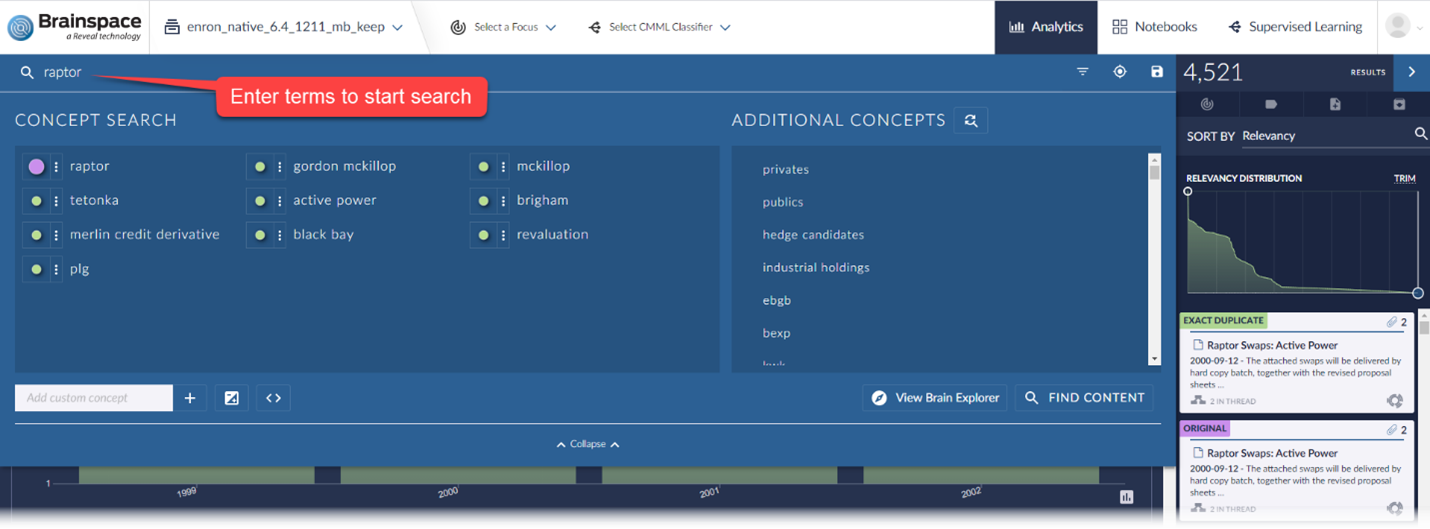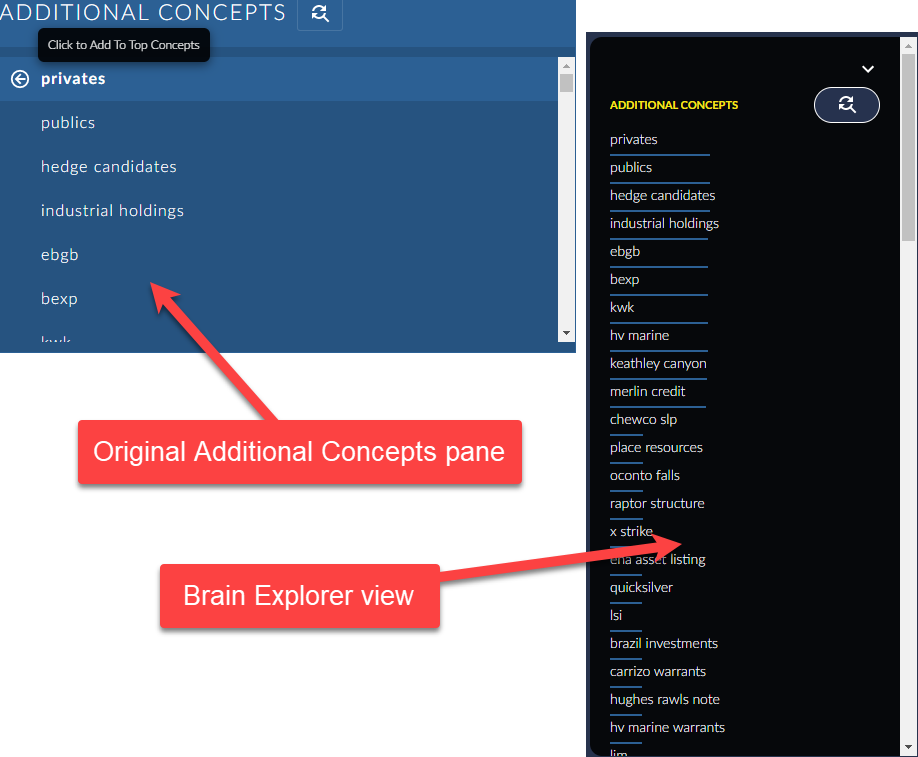Introducing the Brain Explorer
The Brain Explorer, coming soon with Brainspace 6.6, will be the latest feature from Reveal designed to provide enhanced data interpretability and transparency. A new interactive way to visually explore the relationships between concepts in your data, the Brain Explorer helps you get to critical concepts and content more quickly than ever.
As they say in the late-night commercials, “But wait, there’s more!” Not only will you get the Brain Explorer, included will be Reveal’s inaugural implementation of in-context help, Brain Explorer Help.
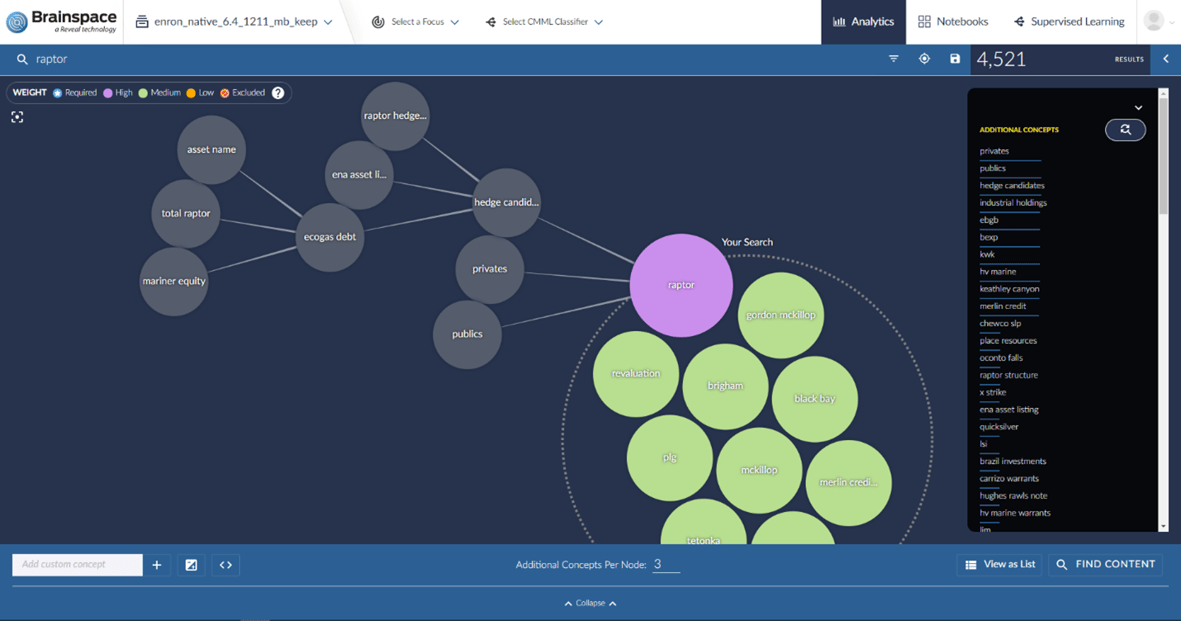
Brainspace's Traditional Approach: the Concept Search Drawer
Before we examine the Brain Explorer, let’s look at the traditional Brainspace approach to searching concepts, the Concept Search Drawer. We will use, no surprise, the Enron data.
Go to Brainspace and enter a term, such as the oft-used raptor, in the search box in the upper left corner of the window. Results are displayed in the space immediately below the search box.
Concept Search pane
On the left are the top ten concepts: raptor, tetonka, merlin credit derivative, plg, gordon mckillop, active power, black bay, mckillop, brigham, and revaluation.

Each concept is automatically assigned a weight. That weight identifies how closely or distantly the concept term is from the search term. Weights are indicated by dots that come in three sizes and colors. The large purple dot is used for concepts most closely related to the search term. The small gold dot is for concepts most distantly related. The medium green dot indicates concepts in the middle.
You can adjust the weight assigned to each concept. To do that, click on the dot to the left of the concept and select the desired option.
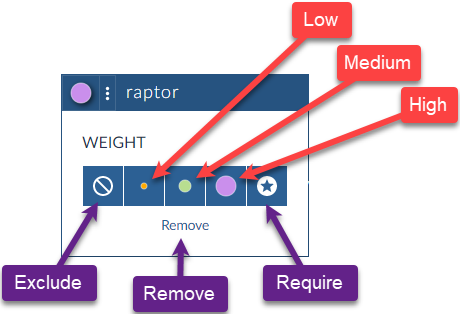
-
- Exclude: You can opt to exclude the term from the search results.
- Law: You can change the term’s weight to low.
- Medium: You can change the term’s weight to medium.
- High: You can change the term’s weight to high.
- Require: You can require that the term in the concept search results.
- Remove: You can remove the term from the Concepts Search pane.
Additional Concepts Pane
To the right is a list of additional concepts. With this search they are privates, publics, hedge candidates, industrial holdings, egbg, bexp, and so on.
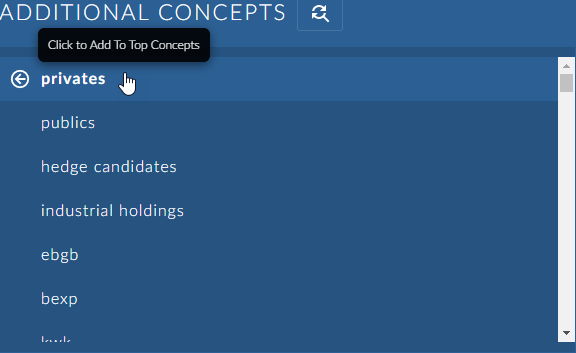
You can click on any of the concepts in the Additional Concepts pane to add it to the Concept Search pane.
A New Way of Visualizing Concept Searches:
The Brain Explorer lets you see – and work with – the same information but in a new, more visual, and more dynamic way.
Navigating to the Brain Explorer
Start by clicking on the View Brain Explorer bottom at lower right side of the Concept Search Drawer.
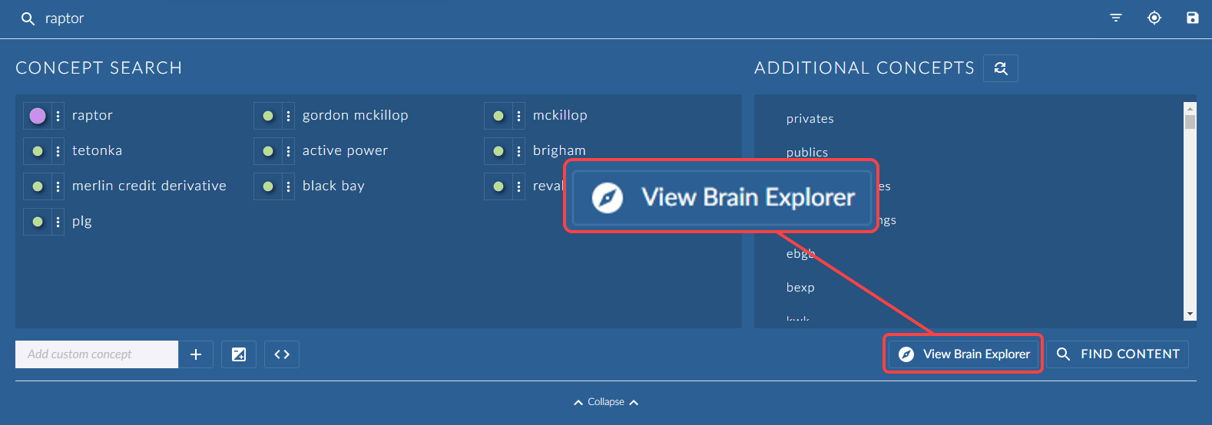
This takes you to the Brain Explorer, a visual way for you to explore relationships between concepts and amend concept-based searches.
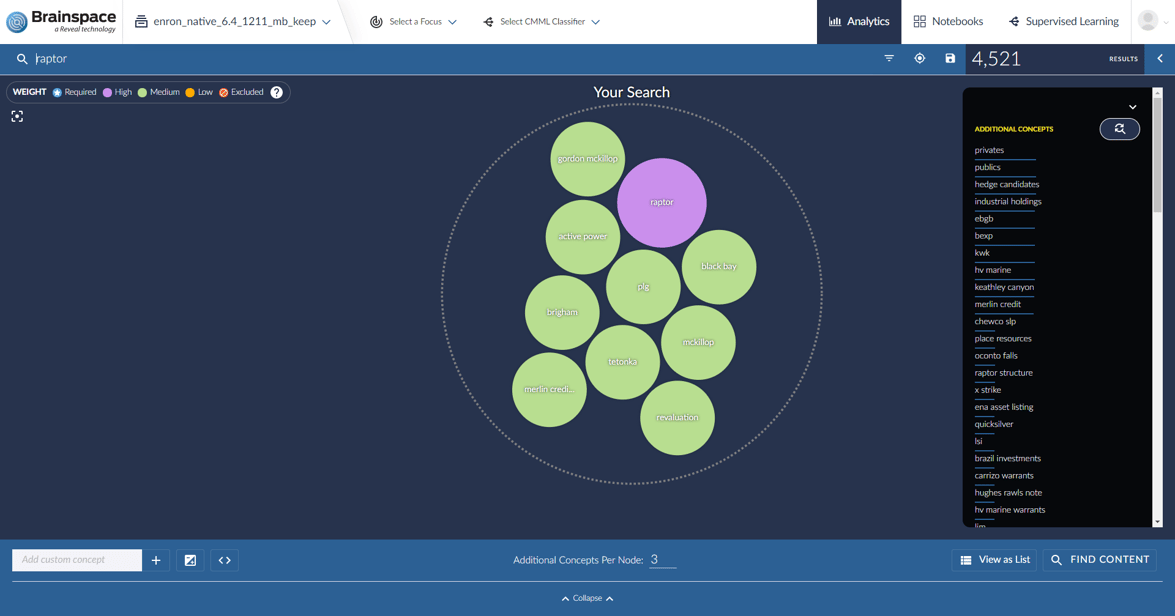
All the same elements are there. Top concepts now are shown in the shaded area called Your Search that occupies the left side of the window.
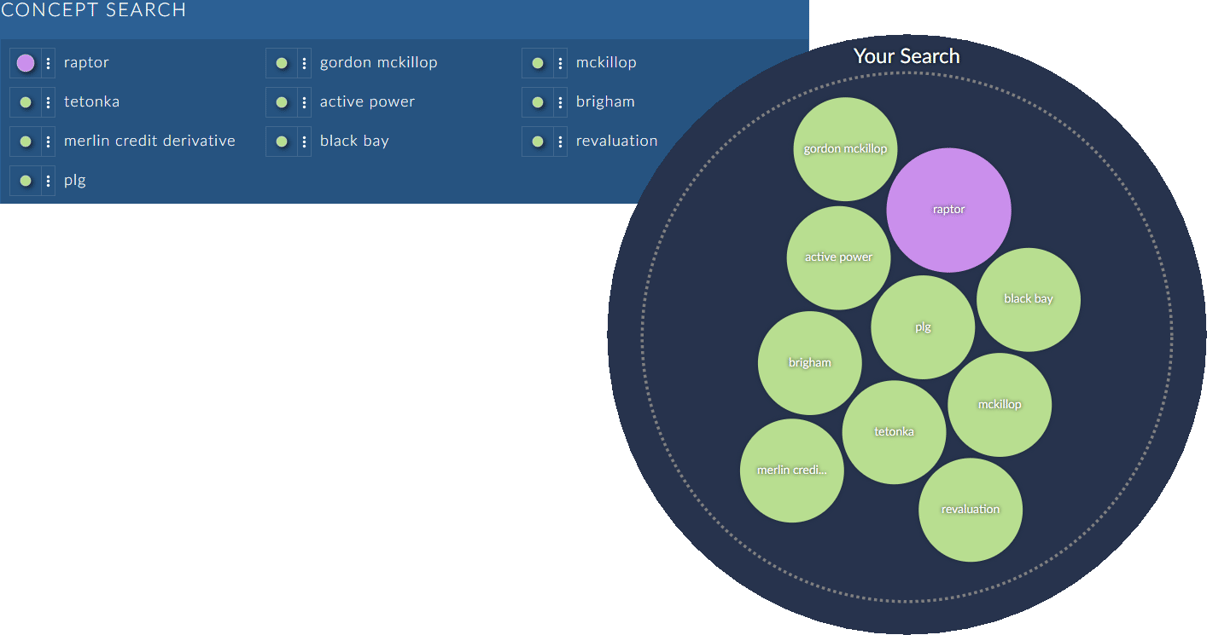
Additional concepts now are displayed in the darker area on the right, named Additional Concepts. These are concepts the AI thinks might be related to your query and that you might want to add to your query.
Using the Brain Explorer
Concepts appear in the Your Search area as colored circles, or Nodes. The circles use the same colors and iconography as before. The colors and iconography are explained in the persistent bar at the top of the window. The Brain Explorer also gives you capabilities you did not have before.
![]()
Drill for Details
By clicking on one of the nodes, you can bring up additional concepts related to it. By default, three additional concepts are shown for each node. You can increase or decrease that number.
You can keep drilling deeper as longer as there are additional concepts to be found. Here, I went nine levels deep.
-png.png?width=1265&name=node-levels-2%20(1)-png.png)
Add and Remove Concepts
You can move concepts from the Additional Concepts area to the Your Search area simply by clicking on them. Here, I added two concepts, “keathley canyon” and “x strike”.
-png.png)
To remove a concept, click on it and drag it outside the dotted search circle.
To add a concept not shown currently, use the Add Custom Concept box and search for concepts by name. Type a concept name and hit Enter or + to add it to your search query.
-png.png)
Change the Weight
To change the weight assigned to a concept, right-click on the concept and choose one of the options, just as you would in the Concept Search Drawer.
-png.png)
Tips and Tricks
There are multiple ways to act on elements in the Brain Explorer. Here are some of the actions and shortcuts you can use:
Click a Concept Node
Click a Concept Node to expand three related concepts. Click it again to expand three more.
Right-Click a Concept Node
Right-click a Concept Node to see options to change the weight of the Node if it's already inside the search query or to remove the Node from the query. If the Node is not in the query, you will see options to add it.
Double-Click a Concept Node
Double-click a Concept Node to collapse all relations.
Drag a Concept Node into the Concept Search Area
Drag a Concept Node in the Concept Search Area to add it to the search query.
Drag a Concept Node out of Concept Search Area
Drag a Concept Node out of the Concept Search area to remove the concept from the search query.
Move the Additional Concepts Area
Click, hold, and drag to move the Additional Concepts area to another part of the screen.
Refresh the Additional Concepts Area
After you have been working in the Concept area and have changed the concepts displayed there, update the list of suggested concepts shown in the Additional Concept area by clicking the magnifying button.
In Context Help
Along with Brain Explorer, Reveal will introduce help that is displayed in context. The first implementation of this will be Brain Explorer Help.
To access Brain Explorer Help, click on the question mark icon in the persistent bar at the top left of the Your Search area.
-png.png?width=1060&name=persistent-bar-1%20(1)-png.png)
This brings up in-context help for Brain Explorer.
-png.png)
This help function gives access to just-in-time assistance. If offers explanations for how to use features you see on the screen. The explanations are accompanied by pictures and videos designed to provide a richer explanation than is available through words alone.
Learn more about Brainspace and Reveal’s other AI-driven capabilities
If you and your organization would like to learn more about how you can harness the innovative features available in and coming to Brainspace as well as how Reveal uses AI as an integral part of its AI-powered end-to-end legal document review platform, contact us to learn more.


